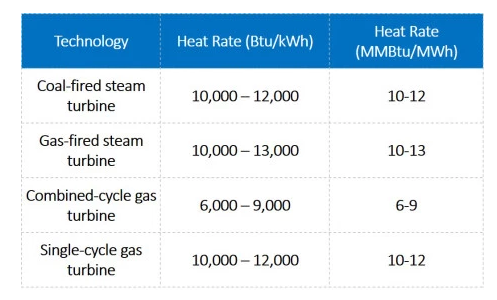A Little Math Shows Switching to Natural Gas Will Probably Increase Fuel Costs for Minnesota Ratepayers
It’s a common refrain for energy policy: it is cheaper to generate electricity from natural gas than coal. In some respects this is true, but power plant efficiency and fuel prices are important variables we should consider before we completely shutter Minnesota’s coal fleet in favor of renewables and natural gas.
Combined cycle natural gas plants are more efficient than coal plants because they use the heat produced as gas is burned to make 50 percent more electricity. It’s hard to explain, so I’ve included a video below.
However, not all natural gas plants are combined cycle plants, and many of the plants used to generate electricity when the wind is not blowing are combustion turbines (CT) that do not capture the heat and convert it to electricity. Therefore, these plants are about as efficient as a standard coal-fired power plant.
Power plant efficiency is measured in something called a heat rate. The table below shows standard heat rates for different kinds of power plants. The lower the heat rate, the more efficient the power plant is. As you can see, CC gas is the most efficient. This is where the math comes in.

Coal and natural gas are often priced in dollars per million British thermal units (mmBtu). In 2016, the delivered cost of coal to Minnesota power plants was $2.06 per mmBtu, and natural gas cost $3.10 per mmbtu, according to the Energy Information Administration.
This information gives us an easy way to calculate the cost per megawatthour:
For Coal: $2.06 (cost per mmbtu) x heat rate of 10 = $20.60 per MWH
For CC Gas: $3.10 (cost per mmbtu) x heat rate of 6.6 (which is the standard EIA heat rate) = $20.46 per MWH
For CT Gas: $3.10 (cost per mmbtu) x heat rate of 10 =$31.00 per MWH
As you can see, whether natural gas is cheaper than coal depends on the type of power plant that is generating electricity. Burning natural gas at a combined cycle plant is slightly cheaper than a coal plant, but burning natural gas at a CT plant is 50 percent more expensive than a burning coal for that same amount of electricity.
Although CC gas currently has a lower fuel cost than coal, this can change very quickly. In fact, if the cost of natural gas were to increase by just 10 cents, it would bring the per MWH cost up to $21.12.
EIA currently forecasts natural gas prices will remain low, but even if the Henry Hub price stays around $3.oo/mmbtu, the cost of delivering the gas to Minnesota power plants probably means burning gas to generate electricity will cost Minnesotans more per kilowatt hour than burning coal.
In short, completely shuttering Minnesota’s coal fleet will put ratepayers at greater risk of paying higher fuel prices in the future due to even small increases in prices for natural gas.
The Trump administration has announced it will replace Obama’s Clean Power Plan with the Affordable Clean Energy Act. This rule will allow coal plants to improve their heat rate, which will make them more efficient, and therefore result in fewer emissions while at the same time reducing the cost of electricity. These are the sorts of win-win policies we should be pursuing, not decarbonization at any cost.